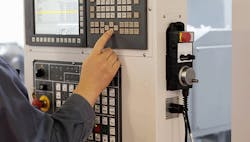Physical interfaces to various processes and functions have been around forever. Allen-Bradley was initially formed by creating a speed control for dc motors using compression graphite resistors. The operator would turn the knob to change the resistance of the graphite to change the speed of the motor. The feedback for this action was vision. The era was circa 1926.
I was so excited to view the “Get Back” Beatles documentary on Disney+, which was put together by Peter Jackson of “Lord of the Rings” movie fame.
Also read: What do the stack lights mean in the visual factory?
I had read about the source of the film from 1969 on various websites, and, as a Beatles fan, I couldn’t wait. While I wasn’t disappointed, there was an intense wow factor that they created such awesome music on home-built mixers and recording equipment.
I was especially fascinated with the mixer board that producer Glyn Johns and his crew were using to record the sessions that went on in the studio.
The mixer was a collection of levers and meters and buttons that provided the technician the ability to mix the sounds coming from the studio. In fact, many of the recordings from these sessions were included in the “Let It Be” album, so they were record-worthy.
The volume unit (VU) meters have a red band, which suggests that the input to the channel can be overdriven and can lead to distortion. The technician would try to keep the needle from going into the red zone for too long—physical interface at its best.
Being a musician myself, we used mixers with knobs and slide bars but it had only one meter on it. While we were a travelling band, we did not have a sound guy, so we had to set things up and then hope it all worked out.
I remember in the late 1970s being involved in the design and implementation of operator consoles that consisted of many pushbuttons and pilot lights. The top of the console typically was sloped, so the operator could see the nameplates assigned to each and every button and light.
A flashing light meant trouble.
What was driving these interfaces varied since programmable logic controllers (PLCs) were just becoming the new kid on the block; relays could still be driving these devices.
Out on the floor there typically would be a local control station for manual control and operator console override. The real issue here is that you need line of sight to see what was going on at the machine or process level.
I was in a multiple-CNC installation just a few years ago to install some software for data collection. While I was on the floor, I had no idea if one of the 26 CNC machines had failed. The company had no way of knowing except for the CNC screen.
Stack lights, or tower lights, have been around for a while. The reason they would be used is strictly for machine health, operational state and/or function. They could complement a screen-based interface, such as an HMI, but the main benefit of these physical machine interfaces is that you can get these larger lights and alarming systems up into the air so that they can be seen from various angles.
They would typically be driven by PLC-based control systems using discrete outputs, however in our new automation era they can be driven over Ethernet using messaging.
Also read: Stacklights: how much is too much?
I was involved in a project at a local brewery where it needed to have machine status, as well as production information, displayed to the floor personnel. Stack lights would not have worked in this application, but alpha-numeric marquee screens, which could be read from 200 feet away, worked very well.
Electronic HMI and process interfaces have their places, without a doubt, and are probably the go-to solution for any and every application. There are limitations to these solutions, however. Sometimes we need to get back—no pun intended—to basics. Physical interfaces still have their place in our automation repertoire as we continue down our long and winding road.
It is just how we transmit the information to the people who need it in a timely manner and in a manner that serves the purpose. Just because there isn’t a screen or software involved doesn’t mean they can’t be useful and needed.
The lowly pushbutton is still a best seller in the world of industry. I remember selling stainless-steel paddle pushbuttons to a lumber mill since the operator would hit the button with a pickeroon after positioning a log in the saw. Don’t think that would work with a screen-based HMI.
Don’t forget how we got here. A physical interface still has its place. Let it be.
Jeremy Pollard, CET, has been writing about technology and software issues for many years. Pollard has been involved in control system programming and training for more than 25 years.
About the Author

Jeremy Pollard
CET
Jeremy Pollard, CET, has been writing about technology and software issues for many years. Pollard has been involved in control system programming and training for more than 25 years.

Leaders relevant to this article:

